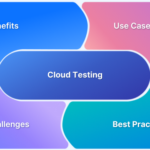AI in software testing has moved from being an innovative idea to a regular practice for accelerating development, increasing efficiency, and enhancing precision in software delivery. With the rate of digital transformation speeding up and customer demands setting new benchmarks, development teams are using AI in software testing to automate their testing processes, reduce time-to-market, and improve software reliability. It enables teams to make smarter decisions, boost test coverage, and automate repetitive tasks.
1. Intelligent Test Case Generation
One of the most labor-intensive tasks in manual testing is the generation of comprehensive but relevant test cases. AI can alleviate this issue through the automated creation of test cases using analysis of application usage history, test history, user flow, and system logs.
For example, in a sophisticated e-commerce application, AI tools may emulate user actions like browsing, adding to the cart, and placing an order. These can be used to emulate scenarios that imitate actual user actions, hence making the tests more relevant.
2. Predictive Analytics for Defect Detection
AI can predict areas of probable failure in advance by analyzing historical data and anticipating patterns that are associated with bugs. This enables prioritization of testing efforts, reducing defect leakage into production, and more effectively guiding the development teams towards quality code.
Companies that incorporate AI in their test management systems often utilize predictive models in order to mark high-risk modules based on past failure histories. Not only does it boost productivity, but it also re-targets testing against business-critical components of the application.
3. Visual Validation and UI Regression Testing
Modern software interfaces evolve rapidly, especially with the demand for mobile-first and responsive web design on the rise. AI-powered visual testing can compare UI screenshots between different builds to detect layout modifications, misalignments, or issues with rendering that would otherwise go undetected by automated tests.
With the help of image recognition and pixel-level analysis, AI tools can perceive slight changes that can affect the user interface. This is particularly beneficial in applications with frequent UI updates, where human testers cannot possibly identify all the visual bugs.
4. Self-Healing Test Scripts
A significant point of pain with automated testing is script fragility. Small differences in the user interface or in the underlying code usually mean that tests become broken, which increases maintenance efforts. AI remedies this issue by employing self-healing scripts that will automatically modify in response to application changes.
For instance, when a button’s position or ID is altered slightly, AI can use context clues and previous interactions to learn what the new element is and permit the test to run without human intervention. This capability will offer continuity to testing pipelines as well as improve the time saved updating scripts.
5. Test Optimization and Redundancy Elimination
Large test suites might contain redundant or low-value tests. AI can examine execution history, failure rates, and usage metrics to remove unnecessary tests while maintaining coverage.
This kind of intelligent test optimization leads to shorter execution times, faster feedback loops, and lower computational costs. Teams can also use AI to recommend which tests to run for each new code commit, delivering maximum value from continuous testing efforts.
6. Natural Language Processing (NLP) in Testing
AI-based NLP technology enables stakeholders and testers to create automated test cases in simple English that can be executed as scriptable code. This closes the communication gap between technical and non-technical stakeholders and QA engineers, enabling enhanced collaboration with less miscommunication.
NLP-driven test tools have a unique application in behavior-driven development (BDD), where business contexts are written in plain, human-readable language. These are translated into functional tests using AI with the least amount of human effort.
7. AI-Powered API Testing
API testing is essential in modern software architecture. AI assists API test automation through anomaly detection, data format verification, and learning expected behavior during previous executions.
AI is also capable of detecting new API tests based on patterns in traffic and thus uncovers gaps in existing test coverage. This results in robust backend validation and aids smooth integrations across services.
8. Intelligent Bug Triage and Prioritization
AI helps classify, prioritize, and assign bugs based on severity, impact, and history. By automating triage, development teams can save time and also ensure that urgent issues are tackled first.
For example, AI may be trained on prior resolutions and team behavior to suggest the best owners for new bugs. It may also associate similar problems to identify deeper root causes, adding value to overall defect management practices.
9. Enhancing Continuous Testing in CI/CD Pipelines
CI/CD requires immediate feedback and continuous test iterations. AI enables this by predicting the most relevant tests to run, parallelizing runs, and eliminating duplicate runs.
In high-speed environments, these abilities allow for the delivery of high-quality software without sacrificing deployment timelines. AI-powered pipelines adapt to changes and keep ensuring test effectiveness even with rising application complexity.
10. Using AI to Improve Accessibility Testing
One of the key areas in software development is accessibility. AI can test applications for compliance with accessibility guidelines such as WCAG by emulating user interactions from visually impaired, hearing-impaired, or motor-disabled users.
Computer vision and voice recognition technology based on AI can assess color contrast, the presence of alt-text, navigation hierarchy, and screen reader accessibility. This enhances usability for everyone and brings software products in line with legal and ethical standards.
11. Cloud-Based Platforms and the Role of Test AI
As software delivery cycles grow faster and more complex, cloud-based platforms have become essential for enabling scalable, intelligent test automation. These platforms help QA teams handle increasing workloads, support distributed environments, and harness AI to enhance decision-making and efficiency in testing.
One of the leading cloud-based platforms in the realm of test AI is LambdaTest, which offers end-to-end solutions to help teams test AI-driven workflows at scale. LambdaTest is an AI-native test execution platform that allows you to perform manual and automated tests at scale across 3000+ browsers and OS combinations and 10,000+ real devices.
LambdaTest goes beyond traditional testing by integrating AI testing tools like KaneAI, which helps teams identify bugs faster, write smarter test cases, and boost overall test coverage through intelligent insights. These capabilities make AI testing more accessible and actionable for modern QA teams.
The platform also supports parallel and geo-distributed testing environments, enabling teams to meet performance and compliance requirements on a global scale. With its built-in AI capabilities, LambdaTest empowers QA teams to shift left, reduce testing costs, and accelerate release cycles—without compromising quality.
12. Real-Time Collaboration and Feedback Loops
AI is not just for executing and reviewing tests but also for ensuring a smooth collaboration among QA, dev, and product teams. With dashboards and insights using AI, stakeholders can see real-time test data, identify bottlenecks, and make evidence-based decisions without depending on manual reports.
These platforms are often integrated with popular project management and version control software, allowing updates and defect status to automatically trickle through. Feedback loops powered by AI promote openness, reduce response times, and allow features to be delivered aligned with business goals.
AI tools can also provide context-sensitive feedback on code reviews, suggesting suitable test cases depending on the functionality being developed. This promotes early issue detection and closes the feedback loop in development sprints.
13. AI in Performance Testing
Another important application of AI in software testing is in performance testing. It is time-consuming and costly to configure test environments and performance settings manually in conventional performance testing. AI facilitates it by dynamically generating load models from actual user traffic and behavior.
AI can monitor and quantify factors such as response time, server usage, memory consumption, and throughput across different test conditions. AI helps anticipate potential performance decline under various use cases so teams can fix bottlenecks before they impact users.
By simulating real-world usage and traffic surges, AI enhances scalability testing and helps decide whether a system can support future growth. Such proactive measures are particularly critical for customer-facing applications in e-commerce, banking, and media streaming companies.
14. AI-Driven Compliance and Standards Validation
In regulated industries like healthcare, banking, and aviation, testing for compliance is a critical need. AI facilitates verification of whether software complies with internal and external regulatory guidelines. It can automate the extraction of significant compliance rules from documents and verify that tests align with such specifications.
Furthermore, AI identifies test gaps where compliance rules have not been certified. This has a significant reduction in audit risk and speeds up regulatory approvals. AI-driven compliance validation provides consistency and removes human errors in understanding complex legal and business requirements.
15. AI-Assisted Mobile App Testing
Mobile applications present unique testing challenges due to the wide range of devices, operating systems, screen resolutions, and network setups. AI helps automate mobile testing by adding tests across different setups and detecting issues specific to a particular mobile configuration.
AI features can emulate touch gestures, GPS refreshes, background tasks, and battery consumption so that end-to-end coverage of real scenarios is possible. They also help in identifying flaky tests that are not consistent across devices, thus adding a layer of dependability.
AI-powered mobile testing platforms can be taught to rank the most critical device-OS combinations according to user behavior and automate regression testing when apps are updated. This reduces the burden on QA teams while maintaining consistent performance in the mobile ecosystem’s fragmented landscape.
Final Thoughts
The use of AI in software testing is transforming QA practices across all industries. From predictive capabilities to intelligent test maintenance and improved accessibility validation, AI is permeating every element of modern testing platforms.
With the need to develop blemish-free digital experiences, embracing AI in practical and strategic ways is most important. Solutions such as LambdaTest provide the scalability and intelligence necessary to bring those visions into a full-fledged, real-time production reality.
AI is no longer a hypothetical software testing tool but a working necessity. Early adopter teams gain enormous dividends in quality, velocity, and customer satisfaction, positioning themselves for success in an ever-more technology-driven future.



